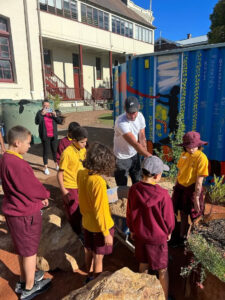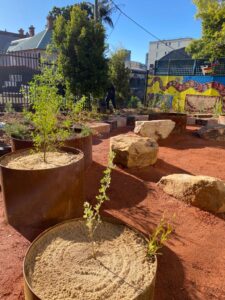
Wildflower: Gardening for good
By Gabrielle Stannus
If you have ever doubted that landscaping could be a vehicle for social change, think again. Working on Gadigal land, Wildflower Gardens for Good are making it possible for their Aboriginal workforce to build financial freedom and personal empowerment through connection to country and community. I spoke with Roman Deguchi, Wildflower Director and co-founder, to find out how this not-for-profit, Indigenous-led social enterprise delivers horticultural services with a purpose.

Growing up in inner-city Sydney, Roman had to navigate early life dealing with the trauma associated with the Stolen Generations. His maternal grandfather only found out about his Aboriginal identity later in life, having been adopted and raised by his non-biological parents as a Fijian man. As a result of this disconnection to culture, members of Roman’s family experienced unemployment, drug abuse, and times of poor mental health. Roman though, was able to break this cycle, firstly by connecting with other young Indigenous boys and girls through representative basketball, and secondly, gaining employment in the horticulture and landscaping industries.
“I have probably had a stronger connection to culture because of that basketball experience, a privilege that my grandfather never had as a member of the Stolen Generations. I finally felt like a part of a bigger family and community. Those friendships and relationships continue today. One of the boys that I played basketball with, Matt Coe, we are still best friends today, and he is the person I started Wildflower with,” Roman explains, “We were young boys with no direction when we were 15, 16 with a path to who knows where. However, we have come full circle, being two men with teenage boys ourselves, to starting Wildflower and doing something that is creating a positive change in our community for the next generation.”
Together, Roman and Matt have 20-year careers in horticulture, community services, and youth work. As an Aboriginal-led not-for-profit organisation, their mission for Wildflower is to change the game by breaking the stigma and cycles that come from lack of opportunity for many young Indigenous men and women. Wildflower offers training programs to Aboriginal people facing barriers to employment, and work planting trees and softscaping, restoring natural areas, landscaping for biodiversity, and installing cultural gardens for a range of government, corporate, and private clients.

Caring for Country
Roman likens the Wildflower approach to horticulture and landscaping to plunking a bit of bush right in the middle of a city: “We want the site to look like a real natural place that belongs there, not a manicured artificial space that has a lot of nice fancy edges and beautiful stonework. We want you to walk through that place and think this belongs here, this looks right. And we feel like all the local wildlife will agree with that too.
“A lot of our work really is plant focused, whereas often I think in landscaping it is the other way around. Landscapers put all the hard structure and everything else in place and then the plants are secondary. Well, we try to do it in reverse. We try to find the perfect plants for the site and then what other elements are going to complement them. We will often bring all the materials into the space and then we will work our way through it.
“Let plants be the highlight. I think that needs to be more of a focus because we are talking about caring for Country. Country does not care about the retaining wall and the beautiful pathway. It is about restoring the plants and therefore the biodiversity that comes with it. I know local government, and government in general, is changing. However, this process probably needs to be faster because you still see a lot of projects with a whole lot of lawn and monocultural murraya hedges.”
The Wildflower crew recently installed an Indigenous cultural garden at Taronga Park Zoo. “Our focus was purely the softscaping – the soils, plants, and mulch, which is what we love to do. We had a lot of fun selecting the plants,” Roman says, “All of them were plants native to New South Wales, with around 80 per cent of them from Sydney or even local to the Taronga Zoo area, and included Correa alba, Banksia ericifolia, Crowea saligna, Acacia longifolia, Melaleuca thymifolia, Actinotus helianthi (Flannel Flower), Plectranthus graveolens, and Banksia spinulosa to name a few.”


Roman is especially proud of Wildflower’s work as part of the project team revitalising the Sydney International Airport, which now features an Indigenous garden at the entrance to the Arrivals forecourt: “It is the first thing international arrivals see when they come into the country, this big, beautiful Indigenous landscape. Not only that, but we have the maintenance contract for it now too. So that is an important message, that not only is the airport’s garden Indigenous, but there are actually Aboriginal people caring for it.”
Caring for people
“Some of the employees we have working at Wildflower are young men that I have known since the day they were born. I visited them at hospital when they were born and now, they are 20 years old and doing great things with us. So, it is an amazing sort of process, but it has been a lifelong sort of journey for us all,” says Roman.
One of those ‘boys’ is Roman’s own godson, who is breaking his family’s cycle of government dependence after growing up in poverty amidst drug abuse. “He has recently moved out with his girlfriend, renting a private apartment, and it is a really nice one too in the city. He is the first in his family that has moved into the private sector. He is renting his own place and pays all his own bills. It might seem to many people ‘Oh, everyone does that’. However, it really is quite special to know his journey and to see how far he has come, and to also think that it is most likely now that he has broken that cycle for good,” Roman explains.

Another recruit to the Wildflower crew recently got out of prison and was able to walk straight into a job with Roman, who says, “That is a very powerful thing for someone to be able to come out of the justice system and know that there is an opportunity waiting for them, and that they are coming into an environment where everyone knows you, everyone understands your journey, and are going to support you all the way through to make sure you do not go back.
“We are dragging these boys literally from the street and we are giving them a job. There is a process involved. When you work with us, you must understand that we are trying to create change in the community, and that is not an overnight thing. From a government or business point of view, if you are working with an Indigenous organisation like ours, it needs to be a genuine exchange, that is, a real interest or support for what we do, rather than tokenistic tick-boxing.”
Going ‘back to school’

Roman says that for many of the Wildflower crew, this is their first experience of paid work. “We realize that for a lot of young people at this stage in their life, they just want to get paid. They want to get a steady income, be able to take their girlfriends out, give their mum some money, pay rent, and buy a nice car. Other things like getting qualified and becoming a horticulturist, and being really career orientated, is probably a little bit secondary. It is also understanding that that is the case for a lot of people in our community too, because we have not grown up in a household that has those sort of role models, where both parents are working, showing us this is the direction that you can take with your life.
“If we told all 15 of our boys to go to TAFE, they probably all will go for a week or two. But then very slowly they will start dropping out and likely probably leave us because it is not something that they are ready for. So, it is about creating a sustainable, and supported, and understanding workplace first and foremost. And we are just lucky enough that we are also caring for country at the same time too.”

Roman says that the Wildflower crew have a lot of fun on the job, especially when working with schools. They like to include schoolchildren in their projects to instil a sense of ownership over the outcome, be it by planting a tree, painting a rock, or doing some artwork for the garden. Recently, Roman and the team ‘went back to school’ themselves, taking on a project at Glebe Public School.
“The Wildflower crew turned a boring and neglected area within the school that was used as a bit of a dumping ground, into a cultural space that encouraged learning, coming together, reflection, and a place to enliven the senses with all the colours, smells, and tastes of the beautiful Gadigal native plants,” says Roman, “I went to school there when I was a young fellow, as did a lot of the boys working with us now. Even the principal remembered some of the boys that were working with us, now building beautiful things for the school. It was a really beautiful thing to see that come full circle.”
Inspired and want to be part of this change? Find out how you can support Wildflower Gardens for Good at www.wildflower.org.au.
Gabrielle Stannus
Inwardout Studio
M: 0400 431 277
E: gabrielle@inwardoutstudio.com
Main photo: The Wildflower crew went ‘back to school’ for this installation in Glebe
